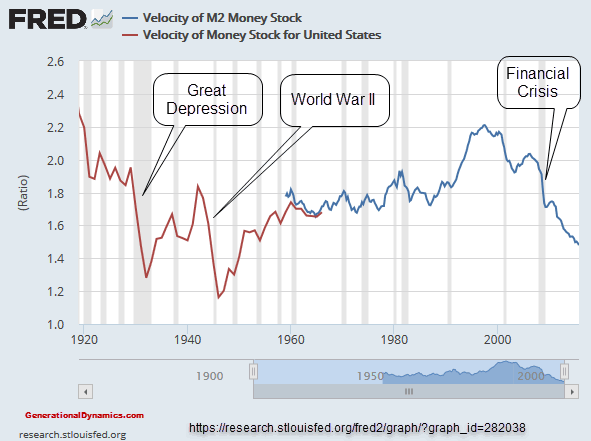Velocity of Money
Mainstream economists (including those in the so-called "Austrian school") think that inflation is determined by the amount of money in circulation as set by monetary policy -- interest rates and quantitative easing. And you can find thousands of articles in the past decade explaining why continued low interest rates would cause inflation.
But anyone who's taken Economics 1.01 knows that inflation is caused by two factors: the amount of money in circulation times the velocity of money. You can google "velocity of money" for a full explanation, but it represents how frequently money is actually used to buy things or pay wages.

The above graph shows that the velocity of money has plummeted three times in the last century: During the Great Depression of the 1930s, following World War II in the 1940s, and during the financial crisis of the 2000s.
Economists -- and I mean pretty much all economists of all ideologies -- are completely oblivious to the velocity of money. If they think about it at all, then they think that if the central bank prints money, then it will raise not only the money supply but also the velocity of money.
What economists don't understand is that they have no control over the velocity of money. It's a generational variable, just like attitudes towards sex or war. A high velocity of money means that people are willing to spend lavishly. A low velocity of money means that people want to save money prodigiously, or to pay off their debts. These are attitudes that are deeply ingrained in people, just like their attitudes toward sex or war. The government cannot change the velocity of money by either monetary policy or fiscal policy.
And if the government can't control the velocity of money, then the government can't control the inflation rate.
Here's what formed Fed Chairman Ben Bernanke said in December: "I think negative nominal interest rates are something the Fed might consider. We’ve seen it put to work in Europe primarily. But the scope for negative nominal interest rates is fairly limited. You can’t get very negative before people will begin to hoard cash, for example, which pays zero nominal interest rates. Although I’ve been surprised by how negative have been able to get in some European countries, I don’t think that, in the context of the United States, I don’t think that it could really be a central tool because I don’t think that rates can get that negative."
It's pretty clear that Bernanke doesn't understand the velocity of money, or thinks that hoarding money is being caused by low interest rates. The causation goes in the opposite direction.
Since 2007, the velocity of money has been decreasing, meaning that people are hoarding their money more, not spending it. This is causing a deflationary spiral, and forcing the Fed to lower interest rates.
As the deflationary spiral worsens, the Fed in desperation will resort to negative interest rates, as has happened in Japan.
Ever since 2003, when I started writing regularly about Generational Dynamics, I've repeatedly written that in this generational Crisis era, Generational Dynamics is predicting a deflationary spiral. Mainstream economists, on the other hand, have been predicting that inflation or even hyperinflation would begin "next year" every year since then. Mainstream economists have been dead wrong, and continue to be wrong, while Generational Dynamics is right. The reason is that mainstream economists are oblivious to the velocity of money. Market Watch (15-Dec-2015) and St. Louis FedDYI Comments: Generational Dynamics is absolutely correct as ultra low inflation and deflation rules the U.S. economic landscape not until Boomer's begin to retire in significant numbers will inflation begin its long march upwards. Demographics has that threshold arriving around the year 2022 when Boomers begin retiring at around age 70.
DYI
No comments:
Post a Comment